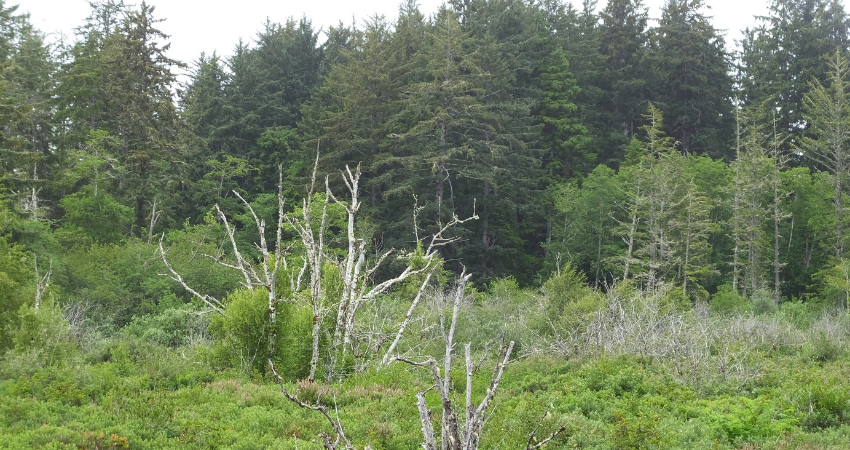
Roundleaf sundew (Drosera rotundifolia), a cool carnivorous plant, can be found at Gearhart Fen.
A visit to the Gearhart Fen is “just like walking into a museum,” ecologist and botanist Kathleen Sayce says.
She would know. Kathleen has spent many hours documenting the plant life in the fen, much of which is conserved as part of NCLC’s Butterfield Fen Habitat Reserve, south of Cullaby Lake in the southeastern corner of the Clatsop Plains. (Her visits there were official in nature; Butterfield Fen is not open to the public, nor are any of NCLC’s properties at this time).


Neal Maine, NCLC’s founding executive director, at the fen.
The 522-acre habitat reserve is technically composed of four contiguous properties, including one with special meaning to NCLC: a 7-acre parcel known as Neal’s Fen. The parcel was donated by the organization’s founding executive director Neal Maine, who purchased it with his wife Karen in 1999 specifically for conservation.
As someone who spent more than two decades guiding NCLC in acquiring lands for conservation, it was especially meaningful for him to contribute an important piece to what would eventually become Butterfield Fen—a safe haven wherein the coast’s wild nature can thrive.
To date, more than 200 plant species have been identified in the fen. They include Labrador tea (Rhododendron groenlandicum); mountain laurel (Kalmia latifolia); four species of orchids; sedges; buckbean (Menyanthes trifoliata); roundleaf sundew (Drosera rotundifolia); and native cranberry, to name a very few. Many are relics of a colder climate.
“They’ve been able to hang on here, even as the climate has warmed, because it’s still wet enough,” Sayce says.
Her interest is in “forensic ecology,” or exploring a piece of land to discover how it came to be the way it currently is, while also investigating how it might have looked in the past. Butterfield Fen is just the right type of place to put those skills to use.
As part of her research, Kathleen can look back on journal entries from the Corps of Discovery, whose members crossed the fen many times during their winter encampment on the coast. However, the plants themselves are the greatest spokespersons for a story that goes back thousands of years.
“It’s the oldest wetland in the system, which means it’s probably more than 5,000 years old,” Sayce says, adding that she considers “the fen plant communities as a remnant, if you will,” of those that were common during the Last Glacial Maximum, or the earth’s most recent ice age some 22,000 years ago.
Unfortunately, Butterfield Fen was modified in various ways prior to conservation, so it no longer functions exactly as it was meant to or as it did before the arrival of European Americans. However, the amount of water in the fen has enabled it to be fairly resistant to non-native plants and retain its ecological value despite the human impact. For example, the peat formed in the fen stores a large amount of carbon.


Fens are typically fed by mineral-rich surface water perched above the local groundwater table.
One piece of living proof that confirms how long the fen has been in place and the stability of the extant plant and wildlife community is the relationship between the wild cranberry and the June copper butterfly (Lycaena mariposa junia), a subspecies of the mariposa copper (Lycaena mariposa). This rare coastal butterfly lays its eggs on the wild cranberry, indicative of a long-term biological connection.
“You’re looking at a relationship that goes back thousands of years,” Kathleen says. “It’s a very interesting story.”
In newer plant communities, she adds, you’re unlikely to find rare species or such deep ecological relationships between insects and plants because “there’s been too much disruption of the ecosystem,” and a dismantling of key pieces. The Butterfield Fen, on the other hand, is “a place where all the parts are still there.”
”If we have a chance of keeping species intact and helping them expand out of that area, these are now biological reservoirs where hopefully they can hang on and become seed sources and organism sources for other plants and animals to go into other areas,” she says.
Comments